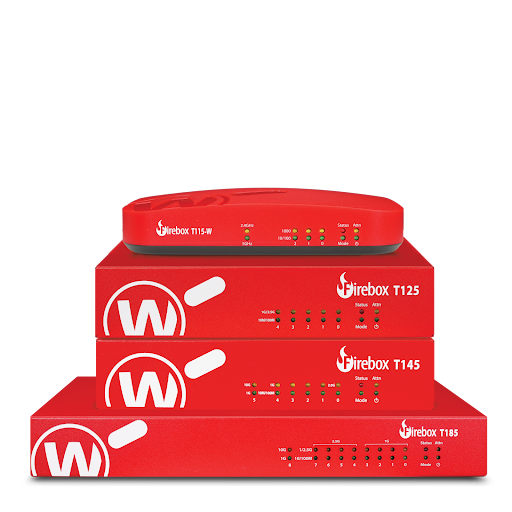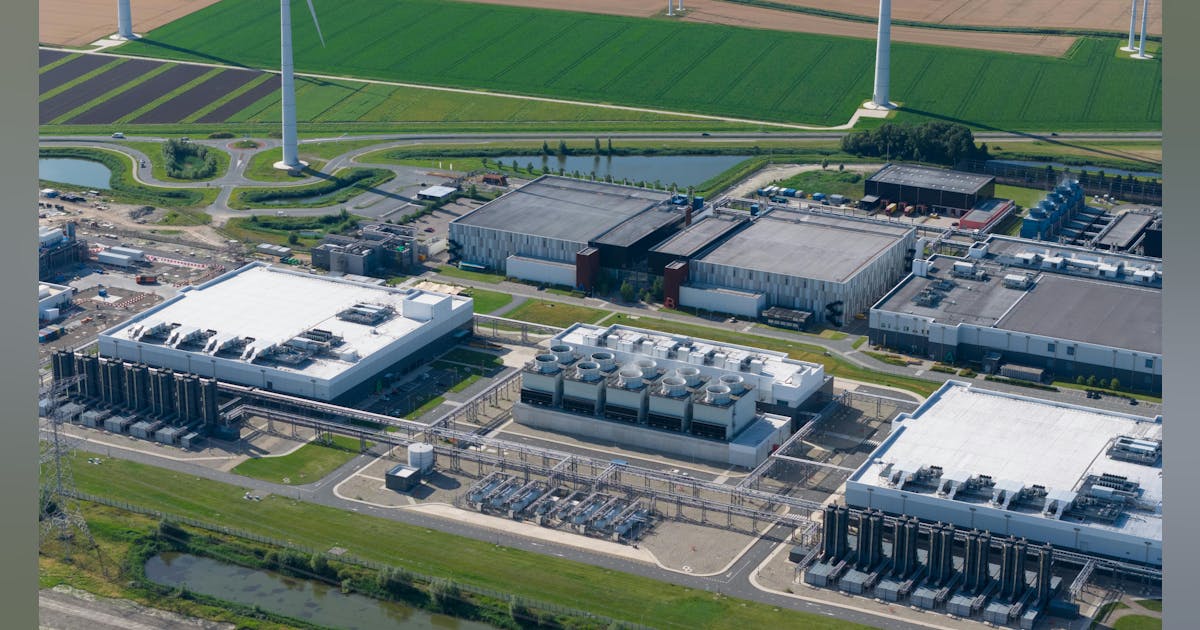Traditionally, product releases can be cumbersome, requiring multiple sign-offs, endless tinkering, bureaucracies and friction points.
The AI workspace company’s lean team practices AI-native working — or ‘vibe working,’ if you will — so that they can move at what they call “gen speed.” This allows them to release new products and features in rapid-fire succession (nearly every week or so), steadily driving up annual recurring revenue (ARR). As the company boasts, it could be “the fastest-growing startup ever in terms of ARR.”
“When people are working the AI-native way, basically everybody is the manager,” Kaihua (Kay) Zhu, co-founder and CTO, told VentureBeat. “They are equipped with a team of AI agents, which are kind of their reportees, and they are capable of, single-handedly, delivering the feature end-to-end. “
AI Scaling Hits Its Limits
Power caps, rising token costs, and inference delays are reshaping enterprise AI. Join our exclusive salon to discover how top teams are:
- Turning energy into a strategic advantage
- Architecting efficient inference for real throughput gains
- Unlocking competitive ROI with sustainable AI systems
Secure your spot to stay ahead: https://bit.ly/4mwGngO
Aggressive rollouts, stoking competition
Genspark, launched in June 2024 by MainFunc, was initially focused on AI search. But despite reaching an impressive 5 million users, the company pivoted away from that initial product to Super Agent, which, instead of following a static sequence of steps as in traditional search, chooses the best tools or sub-agents for the job, gauges results and adjusts in real time.
Launching on April 2, Super Agent is powered by Anthropic’s Claude and can condense an afternoon of white collar office work into 5 minutes, Zhu claims. For instance, it can make calls, download, fact check, produce podcasts, draft documents, perform deep research and pull together spreadsheets and slides.
“We still see it as a kind of search, but it’s more technically advanced,” said Zhu, who has more than 20 years of experience working in search at Google and Baidu.
The company has aggressively added more and more features over the last four months; here’s a rundown of its rollouts and milestones:
- April 11: Reached $10 million ARR just 9 days after Super Agent launch
- April 22: Introduced AI Slides (featuring hundreds of templates)
- April 28: Rolled out a personalized Super Agent with adaptive personalities
- May 2: Hit $22 million ARR, exactly one month post-launch
- May 8: Rolled out AI Sheets that create complete spreadsheets in one click
- May 15: Introduced a fully-agentic download agent and AI drive that manages and stores files
- May 19: Hit $36 million ARR
- May 22: Rolled out AI that can make phone calls
- June 4: Introduced an AI Secretary that manages Gmail, calendars and Google Drive
- June 10: Rolled out an AI Browser and MCP store featuring extended browsing capabilities and a tool marketplace
- June 18: Introduced AI Docs for document creation and management
- June 25: Introduced Design Studio with “Canva-like” capabilities for visual content creation
- July 10: Rolled out AI Pods to create podcasts with simple prompts
- July 17: Introduced advanced editing features for AI Slides
- July 31: Rolled out AI Slides 2.0
- August 1: Introduced multi-agent orchestration that can produce up to 10 agents simultaneously
Genspark is also heating up the AI agent space with friendly competition. After OpenAI announced its ChatGPT agent in mid-July, Genspark performed a comparative analysis and is “very confident” in its ability to overperform the rival. To drive home this point, the company launched a “1 Million Dollar Side-by-side AI Showdown,” challenging users to hunt for cases where other platforms outperform Genspark Super Agent.
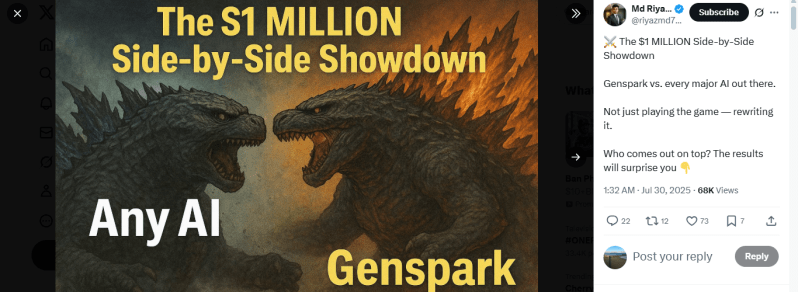
In the first round, users were tasked with building a 12-page financial slide using Genspack and ChatGPT Agent; users identified 429 cases where the latter outperformed the former, each earning $100 for their efforts.
In round 2 (which ended Monday, August 4), Genspark upped the ante to $200 per win and opened the competition to any AI tool as an opponent. Users were challenged to use exactly the same prompt to build slides on Genspark and their chosen AI tool, then upload them to Gemini for evaluation.
“Not trying to start any drama here — just genuinely excited about how far the entire AI agent ecosystem has come,” the company posted on X. “It shows we’re all pushing the boundaries in the right direction.”
Some user reactions:
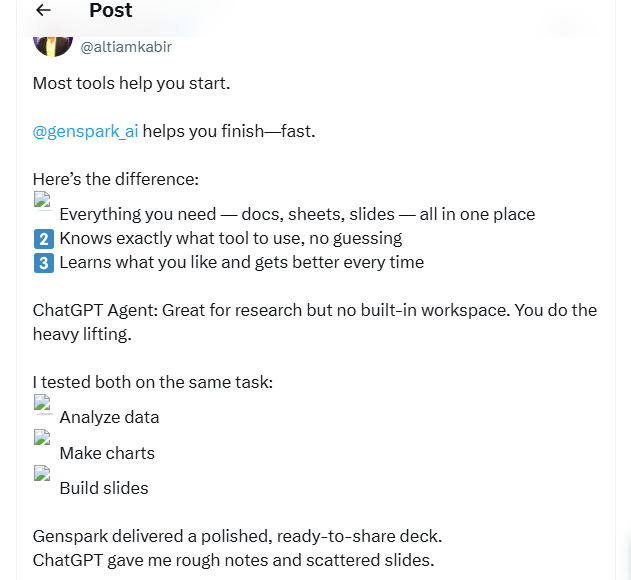
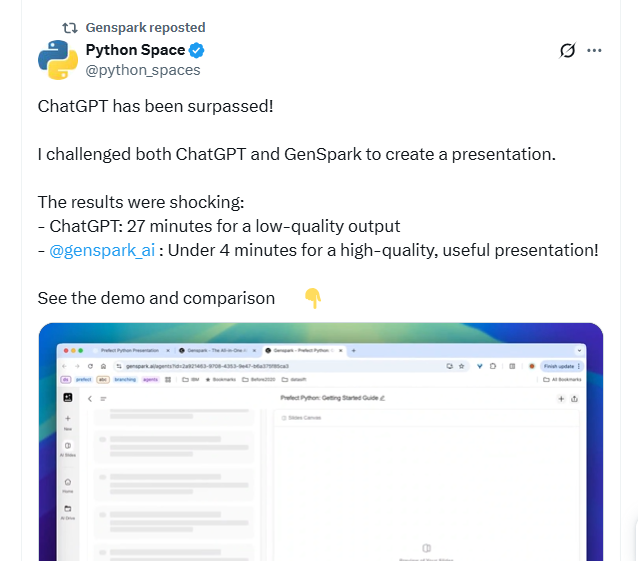
How Genspark’s AI native team vibes
Genspark’s secret is its lean, AI-native team of 20 people and engineering philosophy of “less control, more tools.” Zhu explained that more than 80% of its code is written by AI, which isn’t vibe coding per se, “because vibe coding kind of indicates you never look at the code.” Rather, Genspark has a “very rigid” code review process to help guarantee the quality of their code base.
“We only need a very small AI-native team to operate in a kind of superhero mode, like The Avengers,” said Zhu, who said they’ll gradually add team members as needed. “The AI coding and AI workflow are so powerful, it’s a magnifier.”
Today’s enterprise teams must be reorganized “totally differently,” he said. He’s managed 1,000-member teams with different levels of management and seen how office politics can introduce friction.
Genspark’s team, by contrast, communicates in “a very transparent way,” and productivity is “super high.” “Everybody is working on a product that can ship,” said Zhu. “I believe that that will be the norm looking forward, since AI is actually helping more and more people do their work better.”
He also emphasized the importance of immersing yourself in your own product. From designers themselves to the marketing team, “we actually eat our own dog food. We are our own product consumer. That’s how we will keep improving the experience.”
Inside Genspark’s flagship Super Agent
Zhu noted that, when Perplexity launched in December 2022, it ignited excitement about AI’s potential to transform search. Still, it followed rigid workflows, with platforms having to:
- Analyze queries and expand keywords;
- Retrieve top web results;
- Rerank/summarize for a final response.
This was adequate for basic stuff, but “crumbled” in more complex scenarios like technical comparisons, in-depth research and multi-step and multi-factor purchases. “In essence, it was like trying to navigate a maze with only fixed turns,” said Zhu.
Genspark built its search engine on this same kind of foundation, layering on incremental improvements including specialized data sources, parallel search for deeper investigation into complex queries and cross-checking of asynchronous agents to verify statements too complex for “quick, on-the-fly handling.” But they realized they were still “shackled” by fixed, predefined workflows, Zhu reported.
Super Agent uses nine differently-sized, differently-specialized large language models (LLMs) in a mixture-of-agents (MoE) system. Models break tasks down into steps, delegating based on specialty and strength, then cross-verify one another. Super Agent is also equipped with more than 80 tools (from sub-agents that can generate Python code to ones that can autonomously make phone calls) and more than 10 datasets curated from the web, partners and repositories.
Genspark gives tasks to Claude, OpenAI, Google Gemini, DeepSeek., AI’s Grok 4 and others, “then we let everybody produce their output, and we have an aggregator model to look through the results and analyze which process is most cost-effective,” Zhu explained. “In this way, we improve the accuracy, reduce hallucinations.”
The company also fine-tunes its own frontier model. However, they are not overly aggressive about creating state-of-the-art systems like DeepSeek v3 or v4, Zhu emphasized. The goal is to have the model perform low level but heavy lifting work.
“We are not trying to push the boundary of the frontier model,” he said. “We are trying to bring down the cost and the latency, because a lot of proprietary models are too big, too slow and too expensive for a lot of relatively simple tasks.”
As for the vibe coding trend, Genspark’s goal is to allow everyone to experiment, even for non-programmers where the concept may be a little “too distant.”
“A lot of people think, ‘vibe coding, I’ve heard about it, it sounds cool, but I’m not familiar with the integrated developer environment (IDE), I’m not familiar with code,” said Zhu. “Using Genspark, people can actually vibe.”
Daily insights on business use cases with VB Daily
If you want to impress your boss, VB Daily has you covered. We give you the inside scoop on what companies are doing with generative AI, from regulatory shifts to practical deployments, so you can share insights for maximum ROI.
Read our Privacy Policy
Thanks for subscribing. Check out more VB newsletters here.
An error occured.


